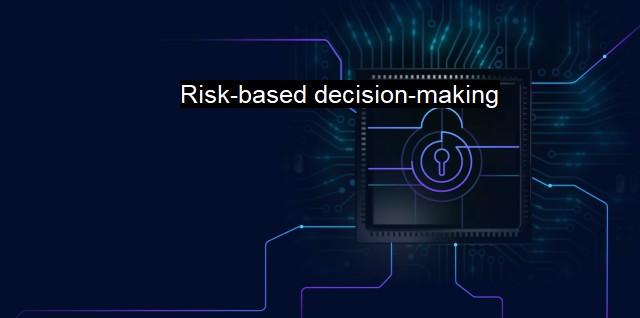What is Risk-based decision-making?
Strategic Approach to Risk-Based Decision Making in Cybersecurity: Mitigating Risks and Enhancing Security
Risk-based decision-making is a principle employed in cybersecurity that enables organizations. Its main purpose is to assess potential threats and vulnerabilities and make strategic decisions based on these evaluations. This principle is a key aspect of leading effective antivirus strategies and maintaining the cybersecurity posture of an organization.Cybersecurity threats proliferate rapidly in today's digital landscape. With every passing day, the sophistication and frequency of attacks escalate, forcing organizations to evolve their defense methodologies. This where risk-based decision-making comes into play. Establishing a successful cybersecurity and antivirus strategy goes beyond just setting up defense mechanisms, it involves consistently evaluating and responding to the associated risks.
The principle of risk-based decision-making rightly addresses this challenge by assessing and prioritizing risks based on their potential impact on the organization. Unlike traditional decision-making strategies that are often reactive, risk-based decisions are proactive, making it possible for organizations to anticipate threats and respond before breaches occur. This approach enhances cybersecurity efficiency, minimizes vulnerabilities, and insulates organizations against unforeseen security disasters.
The process typically begins with identification where potential vulnerabilities within the system are found. This could range from insecure networks, susceptible software applications to human factors. The identified risks are then assessed based on possible harm that could render the organization. This evaluation is crucial for prioritization. Risks with a higher possibility of incidence are given more attention than lesser threats.
The decision-making process also assesses not only the severity of a potential threat but also the likelihood of its occurrence. This comprises a quantitative and qualitative analysis of the risks which impacts the allocation of resources in managing these threats. Thereafter, a rational decision is made to either avert, transfer, mitigate, or accept the risk based on its assessed impact and severity.
For instance, if the outcome of the risk assessment signifies that a particular area of the computer network has major vulnerabilities, the organization would likely invest in a robust antivirus software capable of combating the specific risk and prioritizing resources in that area.
Further, risk-based decision-making also adds to efficiency. Since it involves systematically prioritizing risks, it guarantees an optimum utilization of resources. In a scenario where resources are scarce and threats are abundant, priorities would be set based on the potential impacts of risks, allowing for smarter allocation of resources.
Without a doubt, this approach also contributes to the anticipation of threats. As the cybersecurity landscape evolves, being able to detect and develop responses to potential security threats can be one competitive advantage of an organization. Anticipation allows for the creation of safety buffers and mechanisms, preventing entire system meltdowns and protecting the integrity of the organization.
It is also worthy to note that all the steps applied in risk-based decision making are cyclical, enabling an ongoing process of identification, evaluation, response, and monitoring of risks. This continuous approach allows an organization to keep up with the ever-changing cyber risks and helps them shape contemporaneous strategies to deter potent threats.
Risk-based decision-making is an integral element in managing cybersecurity and antivirus strategies. It employs a systematic and practical approach in understanding, prioritizing, and responding to potential cybersecurity risks. This proactive mechanism not only protects an organization from devastating attacks but helps steer the organization's strategic outlook enhancing efficiency and anticipatory capability. Therefore, for any organization to thrive in this digital age, adopting a risk-based decision-making principle is paramount.

Risk-based decision-making FAQs
What is risk-based decision-making in cybersecurity and antivirus?
Risk-based decision-making is a process that involves assessing the probability and impact of potential cybersecurity threats and choosing the most effective course of action to mitigate those risks. It involves weighing the potential risks and benefits of different strategies to make informed decisions that balance security needs with operational efficiency.Why is risk-based decision-making important in cybersecurity and antivirus?
Risk-based decision-making helps organizations prioritize their cybersecurity efforts by identifying the most significant threats and vulnerabilities and allocating resources effectively. It enables organizations to take a proactive approach to cybersecurity, focusing on prevention rather than reacting to incidents after they occur.What are the benefits of risk-based decision-making in cybersecurity and antivirus?
The benefits of risk-based decision-making in cybersecurity and antivirus include increased efficiency and effectiveness of security measures, reduced costs and resource allocation, improved risk awareness and mitigation, and better alignment of security strategies with business objectives. It also helps organizations to comply with industry standards and regulations while keeping up with emerging threats and vulnerabilities.What are the steps involved in risk-based decision-making in cybersecurity and antivirus?
The steps involved in risk-based decision-making in cybersecurity and antivirus include identifying assets and vulnerabilities, assessing the likelihood and impact of potential threats, determining the risk level and prioritizing the risks, choosing and implementing the most effective security controls, and monitoring and evaluating the effectiveness of the controls. It is an ongoing process that requires continuous monitoring and reassessment to ensure that security measures remain effective in the face of changing threats and vulnerabilities.| | A | | | B | | | C | | | D | | | E | | | F | | | G | | | H | | | I | | | J | | | K | | | L | | | M | |
| | N | | | O | | | P | | | Q | | | R | | | S | | | T | | | U | | | V | | | W | | | X | | | Y | | | Z | |
| | 1 | | | 2 | | | 3 | | | 4 | | | 7 | | | 8 | | |||||||